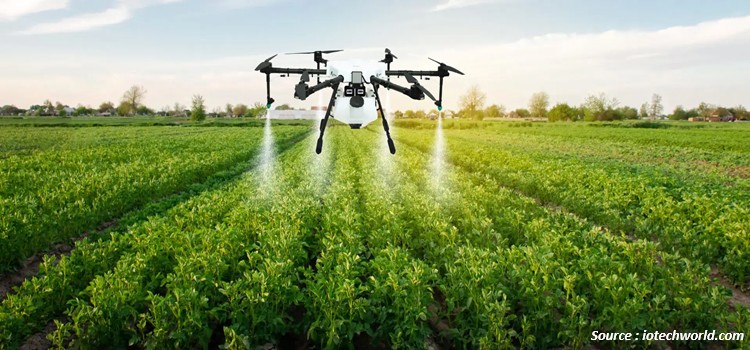
Asia Pacific Agriculture Robots Market by Type (Driverless Tractors, Unmanned Aerial Vehicles (UAVs), Milking Robots, Automated Harvest Robots, and Others), Offering (Hardware, Software, and Services), Farming Type (Indoor Farming and Outdoor Farming), Application (Dairy Management, Irrigation Management, Harvest Management, Soil Management, Inventory Management, and Others), and End User (Field Crops, Fruits & Vegetables, Livestock, and Others) – Opportunity Analysis and Industry Forecast 2023–2030
Industry: Agriculture | Publish Date: 30-Nov-2024 | No of Pages: 198 | No. of Tables: 165 | No. of Figures: 123 | Format: PDF | Report Code : AG631
Market Definition
Asia Pacific Agriculture Robots Market was valued at USD 1.40 billion in 2022, and is predicted to reach USD 6.05 billion by 2030, with a CAGR of 18.8% from 2023 to 2030.
Agricultural robots, also known as agribots or agri-robots, are machines designed to automate or semi-automate various tasks in the field of agriculture. The functionalities of these robots include planting, harvesting, monitoring, and spraying crops. These robots are developed to improve efficiency, productivity, and accuracy in agriculture while reducing the dependence on manual labor and enhancing working conditions for farmers. They utilize advanced technologies like computer vision and artificial intelligence (AI).
Agribots can navigate through fields using GPS or mapping technologies to plant seeds, harvest crops, apply pesticides or fertilizers, and monitor crop health. They are equipped with sensors, actuators, and intelligent algorithms that enable them to perceive their environment, make decisions, and carry out specific actions. They use computer vision to identify and differentiate between crops and weeds, detect pests or diseases, and make precise actions accordingly.
Utilizing Agriculture Robots to Address Increasing Population and Food Demand
Asia Pacific is home to a large and rapidly growing population, resulting in a substantial demand for food. The agriculture robots market in the region is driven by the need to meet this increasing demand through improved agricultural productivity and efficiency. Agriculture robots offer the potential to enhance crop yields, optimize resource utilization, and ensure food security in the face of growing population pressure. Thereby, increasing the adoption of agricultural robots in the region.
Utilizing Agriculture Robots to Address Rising Labor Costs in the Asia Pacific Region
The Asia Pacific region is grappling with a significant increase in labor costs within the agricultural sector. As a result, farmers are actively seeking cost-effective solutions to boost productivity while reducing their reliance on manual labor. This growing need for efficiency has led to a surge in the adoption of agriculture robots as an alternative to traditional labor-intensive farming methods, which is expected to create significant growth in the market.
High Initial Investment as a Barrier to Adoption of Agriculture Robots in Europe
The high initial expenses associated with the purchasing of robotic systems, equipment, and infrastructure are one of the key barriers to the deployment of farm robots in Asia Pacific. This heavy initial expenditure has become a substantial obstacle, particularly for small and medium-sized farmers in the region with limited financial means. Farmers may be discouraged from using agriculture robots due to the high expense of purchasing and installing the essential technologies. Thus, it is expected to restrain the growth of the market.
Asia Pacific Holds Tremendous Potential for Further Advancements and Innovative Technologies.
The ongoing advancements in robotics technology such as artificial intelligence, and machine learning present ample opportunities for agriculture robots market in the Asia Pacific region. These advancements enable robots to have enhanced sensing capabilities, better decision-making algorithms, and increased autonomy. As robots become more intelligent and adaptable to diverse farming environments by performing a broader range of tasks with greater efficiency and effectiveness.
Competitive Landscape
The agriculture robots industry includes several market players such as Naio Technologies, Small Robot Company, Faromatics, Sabi Agri, EcoRobotix, Tevel, Blue River Technology, Robotti, Agrobotics, and Agrobot. These market players are adopting various strategies such as new launches to maintain their dominance in the market of Asia Pacific region.
For instance, in March 2021, the Small Robot Company launched its first robot for weed control. The robot, called Tom, is designed to autonomously navigate fields and identify and kill weeds using a targeted application of herbicide. Tom is the first of three robots that Small Robot Company plans to release in 2023. The company has raised USD 10.7 million in funding to develop its robots, and it has partnered with several major agricultural companies, including BASF and Syngenta.
Key Benefits
-
The Asia Pacific agriculture robots market report provides a quantitative analysis of the current market and estimations through 2023-2030 that assists in identifying the prevailing market opportunities to capitalize on.
-
The study comprises a deep dive analysis of the market trend including the current and future trends for depicting the prevalent investment pockets in the market.
-
The information related to key drivers, restraints, and opportunities and their impact on the market is provided in the report.
-
The competitive analysis of the market players along with their market share in the Asia Pacific agriculture robots market.
-
The SWOT analysis and Porter’s Five Forces model are elaborated in the study.
-
Value chain analysis in the market study provides a clear picture of the stakeholders’ roles.
Asia Pacific Agriculture Robots Market Key Segments
By Component
-
Driverless Tractors
-
Unmanned Aerial Vehicles (UAVs)
-
Milking Robots
-
Automated Harvest Robots
-
Others
By Offering
-
Hardware
-
Software
-
Services
By Farming Type
-
Indoor Farming
-
Outdoor Farming
By Application
-
Dairy Management
-
Irrigation Management
-
Harvest Management
-
Soil Management
-
Inventory Management
-
Others
By End User
-
Field Crops
-
Fruits & Vegetables
-
Livestock
-
Others
Key Players
-
GEA Group
-
CNH Industrial
-
Delaval
-
Deere & Company
-
AGCO Corporation
-
Trimble Inc.
-
Naio Technologies
-
Yanmar Holdings Co. Ltd.
-
SZ DJI Technology Co. Ltd.
-
Boumatic
-
Harvest Automation Inc
-
Autonomous Solution Inc
-
Clearpath Robotics
-
Ageagle Aerial System
-
Kubota Corporation

















 Speak to Our Analyst
Speak to Our Analyst





















